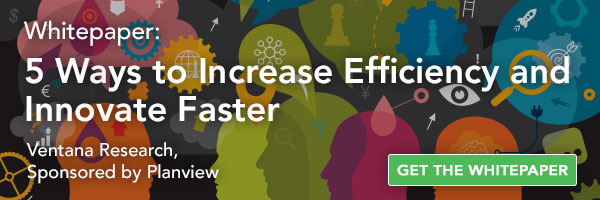
Thus far in this blog series based on the Ventana Research whitepaper, “Five Ways to Increase Efficiency and Innovate Faster,” we have defined work and resource management (WRM), reviewed how your organization can overcome possible hurdles, identified how to assess your current capabilities, and looked into some specific advantages of WRM applications. If you missed any of the previous blogs, catch up by reading through the list below:
- Part 1: What is Work and Resource Management
- Part 2: Overcome Hurdles to Maximize Business Value
- Part 3: Assess the Current State of Your Organization
- Part 4: Advantages of Work and Resource Management Applications
For a quick review, let’s look at the definition of WRM one more time:
“WRM is a systematic approach to prioritizing work and optimizing resources. It uses an integrated set of dedicated applications designed to continuously monitor and streamline processes and activities in ways traditional spreadsheets and project management systems simply cannot.”
Now that we’ve reviewed the basis of what work and resource management is, let’s get into why it is so crucial in the modern work environment. To do so, I have compiled 5 top benefits, listed below.
WRM optimizes efficiency by offering a unified approach to prioritization.
With WRM, you have everything together in one place. This means you can define, document, and execute the right work using the best resources. No longer will you have to dig through endless spreadsheets and emails to see if resources are over-utilized or over-worked; you’ll be able to easily balance workloads to ensure the highest level of efficiency.
Unlike conventional project management, you can combine formal and informal ways of working.
Flexibility is key when it comes to combining different methods of work, a capability conventional systems simply do not possess. They are rigidly structured and incapable of responding to how people actually work. Modern WRM applications, on the other hand, provide a superior level of flexibility that make your organization more agile and capable of optimally managing resources.
Managers can communicate objectives and strategies related to plans effectively.
According to Ventana Research, only 45% of executives can do this well, and only 26% of organizations are able to compare actuals to plans within three business days—a result of static project documents. Plus, most don’t communicate these objectives in a timely manner. The ability to communicate about plans at any time is critical, as you will be better able to quickly respond to changing circumstances, thus improving the productivity of your workforce.
Workers can fully apply their skills to projects and activities by focusing on the most important parts of their jobs.
This enables your organization to be more agile, giving you an advantage over less nimble competitors. Planning and assigning work is suddenly easier, as managers and workers have a more accurate view into workloads, deadlines, and how projects are contributing to organizational goals.
Plans are dynamic and flexible to accommodate teams assembled across lines of business.
It’s a reality of work today that teams are geographically and departmentally dispersed, and your organization must be able to adapt as needed. With the ability to develop and share plans flexibly across departments and locations, you can increase efficiency in both anticipating customer needs and ensuring customer satisfaction.
If you haven’t already, it’s time to make work and resource management a priority in your organization. By doing so, you will not only have more accurate project plans, providing a competitive advantage over the competition, but you will be better able to adapt to the rhythms and issues of work today.
For more information, download the Ventana Research whitepaper, “Five Ways to Increase Efficiency and Innovate Faster,” and learn how Planview solutions can help you get started with WRM by visiting www.planview.com. Don’t forget to read the final part of this series, “Part 6: How to Get Started with Work and Resource Management.”





